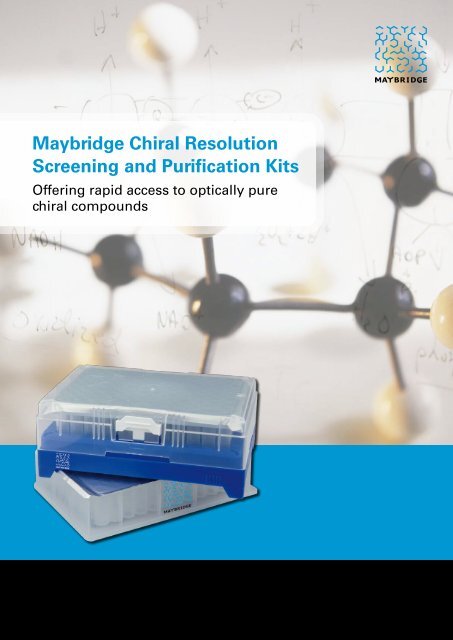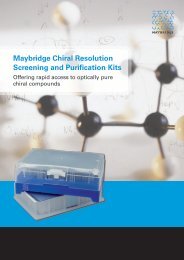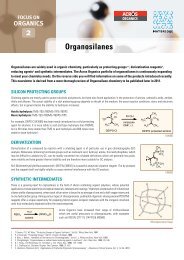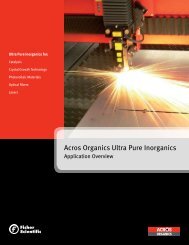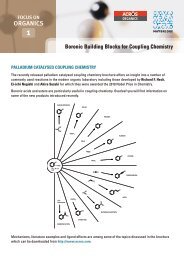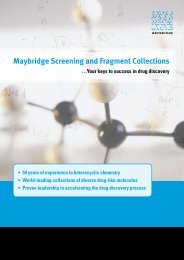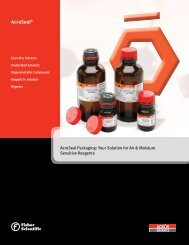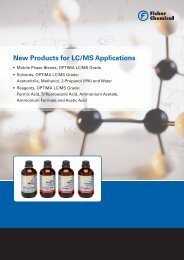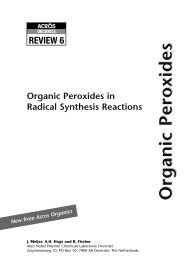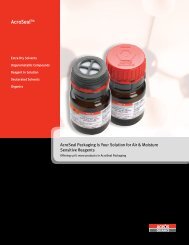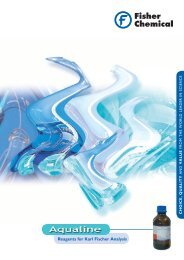Maybridge Chiral Resolution Screening and ... - Acros Organics
Maybridge Chiral Resolution Screening and ... - Acros Organics
Maybridge Chiral Resolution Screening and ... - Acros Organics
Create successful ePaper yourself
Turn your PDF publications into a flip-book with our unique Google optimized e-Paper software.
How the kits work<strong>Resolution</strong> of racemic chiral acids <strong>and</strong> amines can be achieved via the crystallization of their corresponding diastereomeric salt. Theracemic compound, in this example a primary amine, is treated with an enantiomerically pure organic acid (in this case a carboxylic acidbut sulfonic acids can be used as well).Diastereomeric salt formationNH3NH 3NH2+NH2CO 2HR 2 R 3RR1RR1RR1RR1R 3R3O2CR 2O2CR 2Under the right conditions, one of the diastereomeric formed salts will precipitate as crystals whereas the other remains in solution. Itis then possible to separate the salts by filtering the precipitate <strong>and</strong> recrystallizing from a suitable solvent. Further recrystallizations areoften required to achieve the desired purity of the product.Separation via crystallizationNH3NH3NH3RR3R1+RR3R1CrystallizeRR3R1O2CR2O2CR2O2CR2The amine can then be isolated using an alkaline aqueous work-up to give the free base.Regeneration of the single enantiomerNH3RR1NH2R3R2R3O2CR2How to use the kits• Dissolve the racemic starting material (12.0mmol required forthe plastic vials <strong>and</strong> 0.4mmol for the glass vials) in a transfersolvent <strong>and</strong> distribute among the individual vials containingthe resolving agents.• Remove the transfer solvent via evaporation.• Transfer the crystallization solvents to vials containing theracemic starting material <strong>and</strong> resolving agents.• Heat the entire plate to ~80C for up to 5 minutes until ahomogenous solution is achieved. (The plate is chemicallyinert <strong>and</strong> able to withst<strong>and</strong> extreme temperatures.)• Cool the solutions until crystals begin to appear (either roomtemperature or in an ice/water bath).• Analyze the crystals to identify which combination ofresolving agent <strong>and</strong> solvent is optimal.• At any point, recover the racemic material <strong>and</strong> extract <strong>and</strong>purify individual isomers using the components provided inthe Purification <strong>and</strong> Recovery Kit.
Illustrated workflowDissolve racemate intransfer solventHeat to ˜80°C until homogenoussolutions are achievedThermo Fisher ScientificENA 23, Zone 1, nr 1350Janssen Pharmaceuticalaan 3a2440 Geel – BelgiumTel: +32 14 57 52 11Fax: +32 14 59 26 10www.acros.comTransfer racemate. to 96-well plate .Cool until crystals form. (room temp or ice/water bath) .Select best conditions*<strong>and</strong> purify target isomersto desired purityRemovetransfer solventYES.Analyze the vialswith crystalsConditions showingenantiomeric excess?*To purify the target isomer use the <strong>Maybridge</strong> <strong>Chiral</strong> Purification <strong>and</strong> Recovery Kit.Add recrystallizationsolventsRecoverracemate©2012 Thermo Fisher Scientific Inc. All rights reserved. These br<strong>and</strong>s <strong>and</strong> trademarks are part of Thermo Fisher Scientific Inc. <strong>and</strong> its subsidiaries. GC_MB_EEM_1211_159


